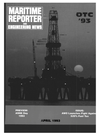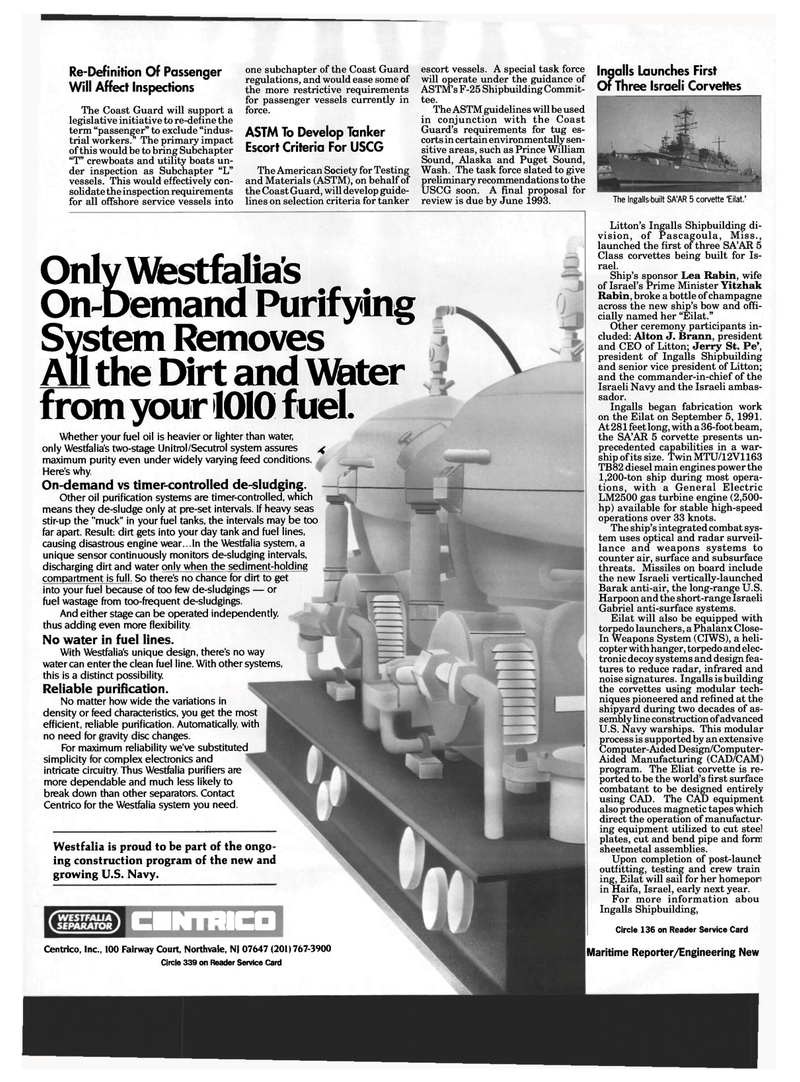
Page 28: of Maritime Reporter Magazine (April 1993)
Read this page in Pdf, Flash or Html5 edition of April 1993 Maritime Reporter Magazine
Re-Definition Of Passenger
Will Affect Inspections
The Coast Guard will support a legislative initiative to re-define the term "passenger" to exclude "indus- trial workers." The primary impact of this would be to bring Subchapter "T" crewboats and utility boats un- der inspection as Subchapter "L" vessels. This would effectively con- solidate the inspection requirements for all offshore service vessels into one subchapter of the Coast Guard regulations, and would ease some of the more restrictive requirements for passenger vessels currently in force.
ASTM To Develop Tanker
Escort Criteria For USCG
The American Society for Testing and Materials (ASTM), on behalf of the Coast Guard, will develop guide- lines on selection criteria for tanker escort vessels. A special task force will operate under the guidance of
ASTM's F-25 Shipbuilding Commit- tee.
The ASTM guidelines will be used in conjunction with the Coast
Guard's requirements for tug es- corts in certain environmentally sen- sitive areas, such as Prince William
Sound, Alaska and Puget Sound,
Wash. The task force slated to give preliminary recommendations to the
USCG soon. A final proposal for review is due by June 1993.
Ingalls Launches First
Of Three Israeli Corvettes
The Ingalls-built SA'AR 5 corvette 'Eilat.'
CENTRICO
Litton's Ingalls Shipbuilding di- vision, of Pascagoula, Miss., launched the first of three SA'AR 5
Class corvettes being built for Is- rael.
Ship's sponsor Lea Rabin, wife of Israel's Prime Minister Yitzhak
Rabin, broke a bottle of champagne across the new ship's bow and offi- cially named her "Eilat."
Other ceremony participants in- cluded: Alton J. Brann, president and CEO of Litton; Jerry St. Pe', president of Ingalls Shipbuilding and senior vice president of Litton; and the commander-in-chief of the
Israeli Navy and the Israeli ambas- sador.
Ingalls began fabrication work on the Eilat on September 5, 1991.
At 281 feet long, with a 36-foot beam, the SA'AR 5 corvette presents un- precedented capabilities in a war- ship of its size. Twin MTU/12V1163
TB82 diesel main engines power the 1,200-ton ship during most opera- tions, with a General Electric
LM2500 gas turbine engine (2,500- hp) available for stable high-speed operations over 33 knots.
The ship's integrated combat sys- tem uses optical and radar surveil- lance and weapons systems to counter air, surface and subsurface threats. Missiles on board include the new Israeli vertically-launched
Barak anti-air, the long-range U.S.
Harpoon and the short-range Israeli
Gabriel anti-surface systems.
Eilat will also be equipped with torpedo launchers, a Phalanx Close- in Weapons System (CIWS), a heli- copter with hanger, torpedo and elec- tronic decoy systems and design fea- tures to reduce radar, infrared and noise signatures. Ingalls is building the corvettes using modular tech- niques pioneered and refined at the shipyard during two decades of as- sembly line construction of advanced
U.S. Navy warships. This modular process is supported by an extensive
Computer-Aided Design/Computer-
Aided Manufacturing (CAD/CAM) program. The Eliat corvette is re- ported to be the world's first surface combatant to be designed entirely using CAD. The CAD equipment also produces magnetic tapes which direct the operation of manufactur- ing equipment utilized to cut steel plates, cut and bend pipe and form sheetmetal assemblies.
Upon completion of post-launch outfitting, testing and crew train ing, Eilat will sail for her homepori in Haifa, Israel, early next year.
For more information abou
Ingalls Shipbuilding,
Circle 136 on Reader Service Card
Maritime Reporter/Engineering New Centrico, Inc., 100 Fairway Court, Northvale, N| 07647 (201)767-3900
Circle 339 on Reader Service Card
Only Westfalia's
On-Demand Purifying
System Removes
All the Dirt and Water from your 1010 fuel.
Westfalia is proud to be part of the ongo ing construction program of the new and growing U.S. Navy.
Whether your fuel oil is heavier or lighter than water, only Westfalia's two-stage Unitrol/Secutrol system assures ^ maximum purity even under widely varying feed conditions.
Here's why.
On-demand vs timer-controlled de-sludging.
Other oil purification systems are timer-controlled, which means they de-sludge only at pre-set intervals. If heavy seas stir-up the "muck" in your fuel tanks, the intervals may be too far apart. Result: dirt gets into your day tank and fuel lines, causing disastrous engine wear...In the Westfalia system, a unique sensor continuously monitors de-sludging intervals, discharging dirt and water only when the sediment-holding compartment is full. So there's no chance for dirt to get into your fuel because of too few de-sludgings — or fuel wastage from too-frequent de-sludgings.
And either stage can be operated independently, thus adding even more flexibility.
No water in fuel lines.
With Westfalia's unique design, there's no way water can enter the clean fuel line. With other systems, this is a distinct possibility.
Reliable purification.
No matter how wide the variations in density or feed characteristics, you get the most efficient, reliable purification. Automatically, with no need for gravity disc changes.
For maximum reliability we've substituted simplicity for complex electronics and intricate circuitry. Thus Westfalia purifiers are more dependable and much less likely to break down than other separators. Contact
Centrico for the Westfalia system you need.

 27
27

 29
29
